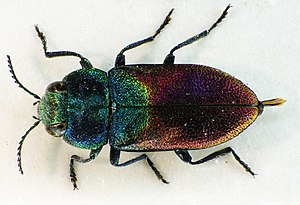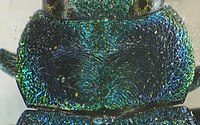Willow beetle
| Willow beetle | ||||||||||||
|---|---|---|---|---|---|---|---|---|---|---|---|---|

Willow beetle |
||||||||||||
| Systematics | ||||||||||||
|
||||||||||||
| Scientific name | ||||||||||||
| Anthaxia salicis | ||||||||||||
| ( Fabricius , 1776) |
The willow jewel beetle or colorful oak jewel beetle ( Anthaxia salicis ) is a beetle from the jewel beetle family (Buprestidae). With a length of five to eight millimeters, it is one of the small, colorful Central European species of the genus Anthaxia . Contrary to what its name suggests, the beetle lives mainly on oaks. There is also a great jeweled willow beetle .
Like most jewel beetles, the species is specially protected by law in accordance with the Federal Species Protection Ordinance. In Germany's Red List of Endangered Species , the species is listed under Category 3 (endangered). In Saxony-Anhalt it is considered to be threatened with extinction , in Schleswig-Holstein as extinct or lost .
Comments on the name and system
The species was first described by Fabricius in 1776 under the name Buprestis Salicis ( Latin jewel beetle of the willow ). The brief description of the beetle by Fabricius is followed by the comment Habitat in Germaniae Salice (Latin: lives on pasture in Germany). This explains the species name salicis , although it does not usually develop in pasture.
The genus Buprestis was broken down into many genera by Eschscholtz in 1829. The genus Anthaxia belongs to the genera with a pointed label . The genus name Anthaxia is from Altgr. άνθος ánthos, "blossom", and άξιος áxios, "worth" derived and indicates the most colorful species of this genus. The genus Anthaxia is represented in Europe in four subgenera with over a hundred species. There are over thirteen hundred species worldwide.
Characteristics of the beetle
The jeweled willow beetle belongs not only to the genus Anthaxia , but also to the subgenus Anthaxia and accordingly has the flat, wider body shape that is characteristic of most species of the genus. The head and pronotum are predominantly blue or purple, the tergites are green.
The head is in the up at the rear edge of the large eyes pronotum withdrawn. The eyes almost completely cover the sides of the head and are brought closer on the forehead (image 1, image 2). The forehead is long and hairy ( pubescent ). The eleven-segment antennae are strong, the outer antennae segments are clearly extended inwards (sawn). The upper lip is bilobed. The upper jaws are strong, curved and pointed. They have a blunt tooth on the inside. The jaws are long, the end link spindle-shaped and truncated. The last link of the lip button is also elongated and truncated.
The blue-green pronotum is characteristically wrinkled. The wrinkles are circular on both sides of the median line of the pronotum (Fig. 3). The jeweled willow beetle differs from the other Central European species with this property in that the hair on the pronotum is not short but, especially on the sides, about as long as the hair on the forehead. This is clearly visible in the larger resolution of Figure 3. The pronotum has the greatest width approximately in the middle, behind it its sides are slightly curved and slightly indented lengthways towards the base.
The elytra are as wide as the pronotum at the base, behind it they run parallel over two thirds of their length. They are broadly rounded at the top. The outer edges of the wing covers become indistinct towards the rear. The label is triangular and like the surrounding area (scutellar spot) blue-green. The rest of the elytra is reddish-copper.
The underside of the body (Fig. 4) shows the characteristics that are important for the classification into the beetle system. The front hip cavities, in which the front legs are turned, are open to the rear. The front hips (picture 4, right red) are spherical and separated by a broad extension of the fore chest (Prosternal process, picture 4, right green). This extension widens at the end of the anterior hip cavity and then ends in a point that bridges the mid-breast and thus apparently divides it (Fig. 4, blue on the right). The rear hips lie broadly against the rear chest and are hollowed out towards the rear to partially accommodate the hind legs ( thigh covers , image 4 right orange). The tarsi are all five-limbed, the claws imperforate.
Occurrence and way of life
The beetles love warmth and are widespread. In Europe occur in Central, Southern and Eastern Europe. They are also found in North Africa and Asia. In Central Europe their occurrence extends to Lower Saxony and the Harz Mountains . They are not found frequently and only in places from May to July on oak wood and the flowers of buttercups . The larvae develop under the bark of dry deciduous trees, especially in oak , but also in willow and maple ( xylobiont ).
swell
literature
- Heinz Joy, Karl Wilhelm Harde, Gustav Adolf Lohse: The beetles of Central Europe . tape 6 : Diversicornia . Spectrum, Heidelberg 1979, ISBN 3-87263-027-X .
- Gustav Jäger (Ed.): CG Calwer 's Käferbuch . K. Thienemanns, Stuttgart 1876, 3rd edition
- Klaus Koch : The Beetles of Central Europe Ecology . 1st edition. tape 2 . Goecke & Evers, Krefeld 1989, ISBN 3-87263-040-7 . P. 96
Individual evidence
- ↑ Fritz Brechtel, Hans Kostenbader (ed.): The splendor and stag beetles of Baden-Württemberg , Eugen Ulmer Verlag Stuttgart 2002, ISBN 3-8001-3526-4
- ↑ Red lists at BioNetworkX
- ↑ JCFabricius: Genera insectorum eorumque characteres naturales secundum numerum, figuram, situm et proportionem omnium partium oris adiecta mantissa specierum nuper detectarum Kiel 1776 p. 257: 237 description of the new species, which is to be classified between the 41st and 42nd species
- ↑ Johann-Friedrich Eschscholtz: Zoological Atlas…. 1st issue. Berlin 1829 Division of Buprestis p. 8
- ↑ Sigmund Schenkling: Nomenclator coleopterologus 2nd edition Jena 1922 Explanation of the scientific beetle names (genus) in short form
- ↑ Anthaxia at Fauna Europaea. Retrieved March 23, 2013 Anthaxia Anthaxia (subgenus) from Fauna Europaea. Retrieved March 23, 2013 Anthaxia Cratomerus (subgenus) from Fauna Europaea. Retrieved March 23, 2013 Anthaxia Melanthaxia (subgenus) from Fauna Europaea. Retrieved March 23, 2013
- ↑ genus Anthaxia at BioLib
Web links
- Anthaxia (Anthaxia) salicis at Fauna Europaea. Retrieved January 6, 2011
- Detailed website on jeweled willow beetles
- Forest information, English



